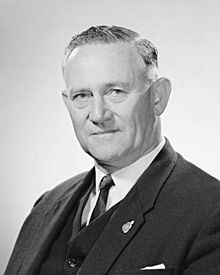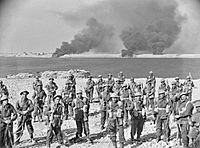David Brand facts for kids
Quick facts for kids
Sir David Brand
|
|
|---|---|
 |
|
| 19th Premier of Western Australia Elections: 1959, 1962, 1965, 1968, 1971 |
|
| In office 2 April 1959 – 3 March 1971 |
|
| Monarch | Elizabeth II |
| Governor | Sir Charles Gairdner Sir Douglas Kendrew |
| Preceded by | Albert Hawke |
| Succeeded by | John Tonkin |
| Minister for Local Government | |
| In office 7 October 1949 – 6 April 1950 |
|
| Premier | Ross McLarty |
| Preceded by | Position established |
| Succeeded by | Victor Doney |
| Personal details | |
| Born | 1 August 1912 Dongara, Western Australia, Australia |
| Died | 15 April 1979 (aged 66) Carnamah, Western Australia, Australia |
| Political party | Liberal |
| Spouse | Doris Elspeth McNeill |
Sir David Brand KCMG (born 1 August 1912 – died 15 April 1979) was an important Australian politician. He was a member of the Liberal Party. From 1945 to 1975, he was a member of the Legislative Assembly in Western Australia.
Sir David Brand was also the 19th and longest-serving Premier of Western Australia. He served four terms from 1959 to 1971. He stepped down as leader of the Liberal Party in 1973. He retired from politics in 1975. He passed away in 1979 due to heart disease.
Early Life and Family
David Brand was born in Dongara, Western Australia. He was the oldest of four children. His father, Albert John Brand, was a farmer. His mother was Hilda, whose maiden name was Mitchell.
His great-grandfather, George Brand, came to Western Australia in 1855. He settled in the Greenough area. David Brand's family joined him there in 1859.
His mother's father was Samuel Mitchell. He was a pioneer in the mining industry in Western Australia. He also served in both parts of the state parliament.
Brand's parents farmed in Northampton. In 1924, they moved to a farm near Mullewa. David left school at 14 to work on the farm. In Mullewa, he became secretary of a local farming group.
In 1935, Brand moved to Kalgoorlie. He worked at the Golden Horseshoe Mine. He did many jobs there, like driving trucks and managing shifts. In his free time, he was active in the Methodist Church. He was also a scoutmaster.
Military Service in World War II

When World War II began, Brand joined the Australian Imperial Force. This was on 23 November 1939. He was a private in the 2/11th Battalion. This group was part of the 6th Division. They went to the Middle East in April 1940.
Brand fought in the North African campaign. He was promoted to corporal. His battalion then went to the Greek campaign. There, on 24 April 1941, he was seriously injured.
Brand was sent back to Australia for more medical care. He arrived in August and was discharged in April 1942. He rejoined the army in September. He became an instructor in Geraldton. In January 1943, he was promoted to Warrant Officer. He was discharged from the army in January 1945.
Political Career
David Brand married Doris Elspeth McNeill on 20 March 1944. They had three children together. After leaving the army, Brand ran a general store in Dongara.
In 1945, the local politician for Greenough passed away. Brand won the election for the Liberal Party. He was the first person in Australia to be elected to parliament for the new Liberal Party.
In October 1949, Ross McLarty became Premier. Brand joined the government as a Minister. He was in charge of Housing, Forests, and Local Government. From April 1950, he was Minister for Works, Water Supply, and Housing. He helped build the Kwinana Oil Refinery. He considered this one of his biggest achievements. He also helped start other large industrial projects.
In 1953, his party lost the election. Brand became the deputy leader of the Opposition. On 1 March 1957, he was chosen as the party leader. His party won the election in 1959. Brand became Premier on 2 April.
His government stayed in power after elections in 1962, 1965, and 1968. This was partly because another party, the Democratic Labor Party, split some votes.
In 1960, the national government allowed iron to be exported again. This helped Western Australia use its large iron deposits in the Pilbara. Mining of bauxite also began. This led to more mineral processing at Kwinana and the South West region. Brand's government also got money for the Ord River Scheme. Large amounts of oil and gas were found in the Pilbara. In 1969, Brand was made a knight.
The growth in mining and farming in the 1960s helped Brand's government win four elections. However, the fast growth of Perth caused problems for services. This made the government less popular after 1969. Brand also had disagreements with the national Liberal Party.
There was a disagreement about demolishing the old Colonial Barracks building. Brand stopped the plan and allowed the building to be restored. This caused stress within his government. Brand collapsed while speaking in public in 1971. He recovered, but his party lost the next election. John Tonkin became Premier.
Brand led the Liberals in opposition until 1973. Sir Charles Court took over as party leader. Sir David Brand passed away in Carnamah, Western Australia in 1979.
Legacy
Several things are named after Sir David Brand. The federal election area called Division of Brand in Western Australia was created in 1984 and named for him. The Brand Highway is also named after him. The Sir David Brand School in Coolbinia carries his name too.
The Sir David Brand Award is the top award for tourism in Western Australia. It recognizes his efforts to improve the tourism industry.
See also
- Brand–Watts Ministry (1959–1962)
- Brand–Nalder Ministry (1962–1971)



